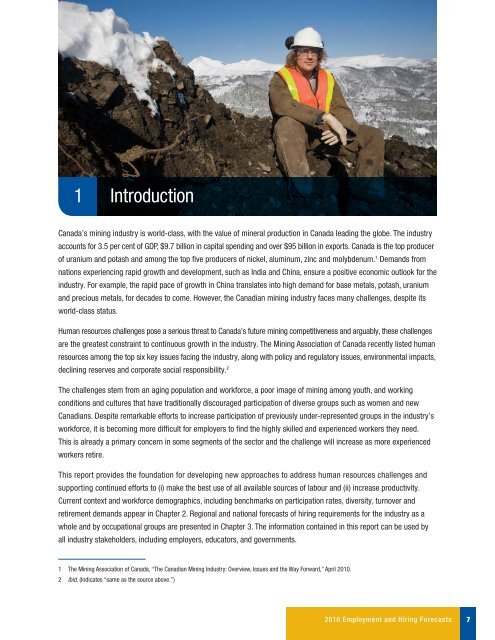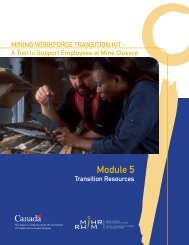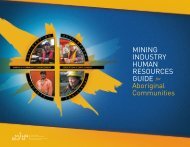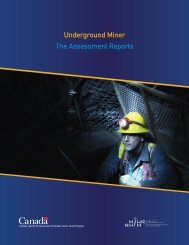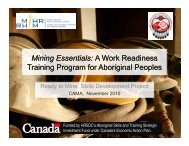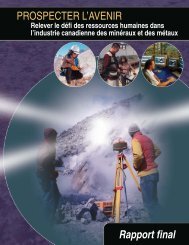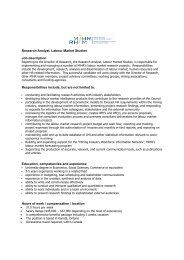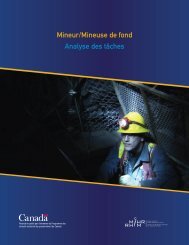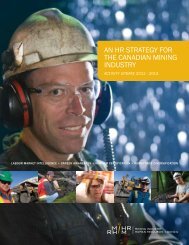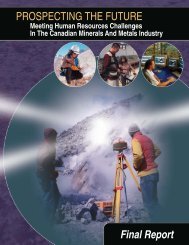Canadian Mining Industry Employment and Hiring Forecasts - MiHR
Canadian Mining Industry Employment and Hiring Forecasts - MiHR
Canadian Mining Industry Employment and Hiring Forecasts - MiHR
Create successful ePaper yourself
Turn your PDF publications into a flip-book with our unique Google optimized e-Paper software.
1 Introduction<br />
Canada’s mining industry is world-class, with the value of mineral production in Canada leading the globe. The industry<br />
accounts for 3.5 per cent of GDP, $9.7 billion in capital spending <strong>and</strong> over $95 billion in exports. Canada is the top producer<br />
of uranium <strong>and</strong> potash <strong>and</strong> among the top five producers of nickel, aluminum, zinc <strong>and</strong> molybdenum. 1 Dem<strong>and</strong>s from<br />
nations experiencing rapid growth <strong>and</strong> development, such as India <strong>and</strong> China, ensure a positive economic outlook for the<br />
industry. For example, the rapid pace of growth in China translates into high dem<strong>and</strong> for base metals, potash, uranium<br />
<strong>and</strong> precious metals, for decades to come. However, the <strong>Canadian</strong> mining industry faces many challenges, despite its<br />
world-class status.<br />
Human resources challenges pose a serious threat to Canada’s future mining competitiveness <strong>and</strong> arguably, these challenges<br />
are the greatest constraint to continuous growth in the industry. The <strong>Mining</strong> Association of Canada recently listed human<br />
resources among the top six key issues facing the industry, along with policy <strong>and</strong> regulatory issues, environmental impacts,<br />
declining reserves <strong>and</strong> corporate social responsibility. 2<br />
The challenges stem from an aging population <strong>and</strong> workforce, a poor image of mining among youth, <strong>and</strong> working<br />
conditions <strong>and</strong> cultures that have traditionally discouraged participation of diverse groups such as women <strong>and</strong> new<br />
<strong>Canadian</strong>s. Despite remarkable efforts to increase participation of previously under-represented groups in the industry’s<br />
workforce, it is becoming more difficult for employers to find the highly skilled <strong>and</strong> experienced workers they need.<br />
This is already a primary concern in some segments of the sector <strong>and</strong> the challenge will increase as more experienced<br />
workers retire.<br />
This report provides the foundation for developing new approaches to address human resources challenges <strong>and</strong><br />
supporting continued efforts to (i) make the best use of all available sources of labour <strong>and</strong> (ii) increase productivity.<br />
Current context <strong>and</strong> workforce demographics, including benchmarks on participation rates, diversity, turnover <strong>and</strong><br />
retirement dem<strong>and</strong>s appear in Chapter 2. Regional <strong>and</strong> national forecasts of hiring requirements for the industry as a<br />
whole <strong>and</strong> by occupational groups are presented in Chapter 3. The information contained in this report can be used by<br />
all industry stakeholders, including employers, educators, <strong>and</strong> governments.<br />
1 The <strong>Mining</strong> Association of Canada, “The <strong>Canadian</strong> <strong>Mining</strong> <strong>Industry</strong>: Overview, Issues <strong>and</strong> the Way Forward,” April 2010.<br />
2 ibid. (Indicates “same as the source above.”)<br />
2010 <strong>Employment</strong> <strong>and</strong> <strong>Hiring</strong> <strong>Forecasts</strong><br />
7


